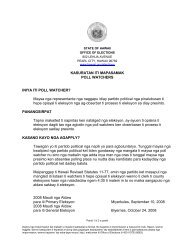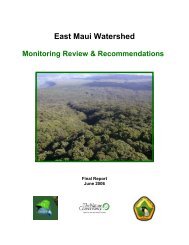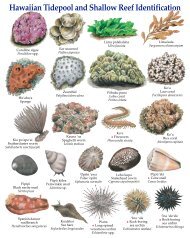Stream macroalgae of Hawai`i: an identification guide - Hawaii.gov
Stream macroalgae of Hawai`i: an identification guide - Hawaii.gov
Stream macroalgae of Hawai`i: an identification guide - Hawaii.gov
Create successful ePaper yourself
Turn your PDF publications into a flip-book with our unique Google optimized e-Paper software.
Tribophyta = yellow, Bacillariophyta = gray.<br />
Distribution information, in terms <strong>of</strong> what is known<br />
so far, is indicated for each genus. It should be<br />
recognized, however, that the potential <strong>an</strong>d likelihood<br />
for extension <strong>of</strong> r<strong>an</strong>ges on other isl<strong>an</strong>ds is high.<br />
Additionally, the reports included in this <strong>guide</strong><br />
represent records from streams only – m<strong>an</strong>y <strong>of</strong> these<br />
genera have representatives in marine, brackish <strong>an</strong>d<br />
subaerial/terrestrial habitats, which are not included<br />
here. The <strong>guide</strong> has been exclusively illustrated using<br />
<strong>Hawaii</strong><strong>an</strong> material.<br />
Collection <strong>an</strong>d preservation techniques<br />
Since almost all stream <strong>macroalgae</strong> require at<br />
least some microscopical examination for <strong>identification</strong>,<br />
collection <strong>an</strong>d preservation techniques should<br />
be developed to fit the needs <strong>an</strong>d intentions <strong>of</strong> the<br />
study. One necessary piece <strong>of</strong> equipment for stream<br />
<strong>macroalgae</strong> sampling is a viewbox (or snorkel mask,<br />
if the collector is in the water; e.g. for fish surveys).<br />
A view box is relatively easy to construct, <strong>an</strong>d c<strong>an</strong><br />
be made by cutting a square hole in the center <strong>of</strong> a<br />
plastic tupperware container, <strong>an</strong>d using silicone<br />
aquarium gel to seal in a piece <strong>of</strong> glass cut to the<br />
correct size. The collection <strong>of</strong> <strong>macroalgae</strong> from the<br />
stream is accomplished most easily using longh<strong>an</strong>dled<br />
forceps, which allow the alga to be removed<br />
in one piece at its base. Inclusion <strong>of</strong> the basal attachment<br />
is import<strong>an</strong>t, since some taxonomic descriptions<br />
use information pertaining to this part <strong>of</strong><br />
the pl<strong>an</strong>t. A few forms may be more easily removed<br />
2<br />
using a single-edged razor blade (e.g.<br />
Hildenbr<strong>an</strong>dia, Calothrix, some diatom films), or<br />
toothbrushes. Some gelatinous growths in side<br />
pools are easily collected using a turkey baster<br />
(e.g. Anabaena). It is also import<strong>an</strong>t to search all<br />
habitats in the vicinity <strong>of</strong> the stream to ensure<br />
that all taxa are represented in the collections –<br />
including rocks <strong>an</strong>d other bottom substrata in<br />
fast-flowing stream areas, slow flowing areas at<br />
the edges <strong>of</strong> the stream, side pools, waterfall faces,<br />
seep faces, floating material in the stream <strong>an</strong>d<br />
vegetation. As well, <strong>macroalgae</strong> prefer different<br />
light regimes, <strong>an</strong>d so both brightly illuminated<br />
<strong>an</strong>d shaded areas should be searched. Scintillation<br />
vials or WhirlPak bags work best for storing<br />
collections from the field, but it is import<strong>an</strong>t not to<br />
overfill the containers with algae since this will<br />
result in their rapid degradation. Most field collections<br />
kept cold (on ice or in a refridgerator) will<br />
remain in good condition for several days.<br />
The most highly recommended preservative<br />
for freshwater <strong>macroalgae</strong> is CaCO 3 -buffered<br />
glutaraldehyde (a 2.5% solution made from<br />
dilution <strong>of</strong> 25% glutaraldehyde, add a pinch <strong>of</strong><br />
CaCO 3 powder to buffer the solution). This<br />
preservative maintains the original color <strong>of</strong> the<br />
specimens very well, <strong>an</strong>d also minimizes the<br />
morphological distortion inherent in the<br />
preservation process. Samples preserved in<br />
glutaraldehyde should be kept cold until they are<br />
identified. Large numbers <strong>of</strong> collections are easiest<br />
to org<strong>an</strong>ize in scintillation vials, since these c<strong>an</strong><br />
be stored in flats <strong>of</strong> 100 vials in a fridge. In the

















